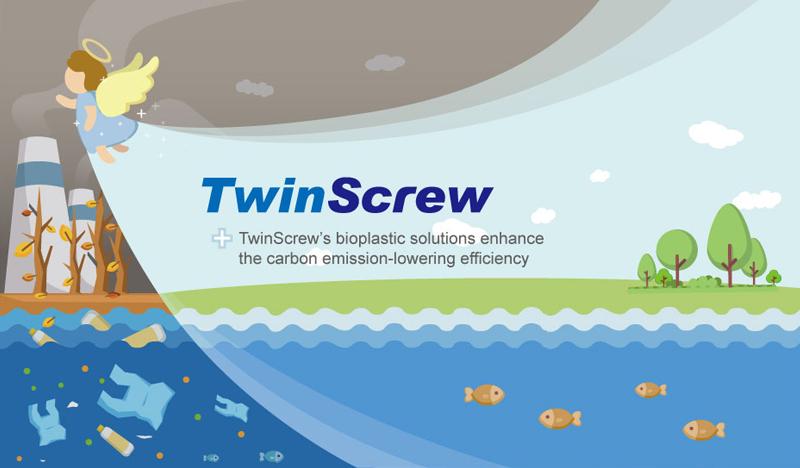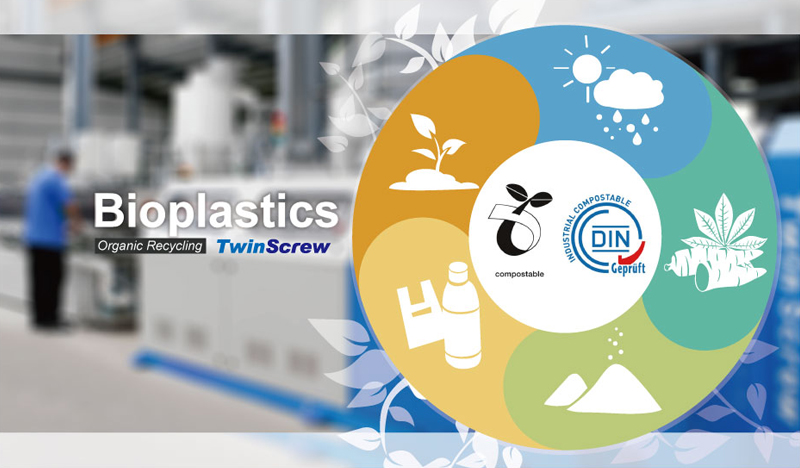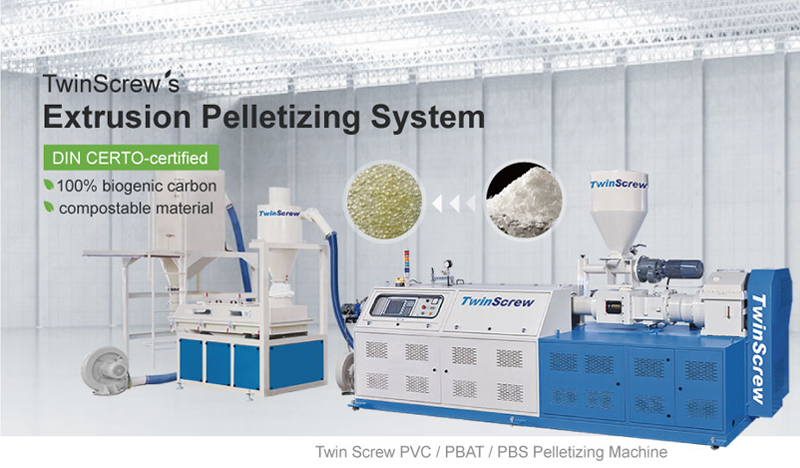TwinScrew’s Bioplastic Solutions Enhance the Carbon Emission-lowering Efficiency

The plastics industry is undergoing critical transformation to achieve the goal of net zero defined in UNFCCC. It is generally accepted that increase in reuse, reduction and recycling are essential actions. However, the latest annual recycling rate is 9% and only 40% of the recycled plastic wastes went to the products though the European area leads the world in awareness of environmental sustainability and recycling infrastructures. Despite of the fact that many countries have implemented incentives for enhancing the reuse and lowering the demands of plastic products, the COVID-19 pandemics dramatically increases the demands of single use plastics giving rise to an opposite consequence.
For achieving UNFCCC’s goal in a more effective approach, the European Bioplastics Association advocates that the use of regenerable biomass to replace or reduce the growth in demand of fossil plastics is critically important. In a perspective of life cycle assessment (LCA), refining and manufacturing of primary raw materials (such as polyethylene, polypropylene, and polyvinyl chloride, etc.) contribute 60% of carbon emission of the entire plastic industry. Apparently, efforts made on reducing or replacing the use of fossil-derived materials gain more effectiveness in lowering carbon emission than that contributed by the later stage of life cycle. Regenerable biomass, such as starch and cellulose, is a naturally synthesized polymer in plants by utilizing clean solar energy along with absorbing carbon dioxide in the air. It is a natural carbon capturing mechanism without consuming fossil energy at all.

According to the data published by the European Starch Association, one ton of air carbon dioxide can be offset for manufacturing each ton of dried starch powder. The results also show that each ton of cellulose produced by sugarcane consumes 2.7 tons of air carbon dioxide. Starch or cellulose is not simply a zero-carbon raw material, but also creates carbon credits for the users if they are appropriately applied.
TwinScrew Industrial Co., Ltd. (herein refer to as “TwinScrew”) foresees user’s requirements for new eco-friendly materials and owns the developed expertise on processing regenerable raw materials such as starch or cellulose. TwinScrew’s tailor-made extruders are successfully manufacturing pellets feeding with starch or cellulosic raw materials. The pelleted products can be easily processed alone or compounded with other polymers for making bio-based products. In a new market segment of green materials, TwinScrew enables clients manufacturing the value-added bioplastic products with a lower carbon burden. Since 2018, the pellets made by TwinScrew’s extruding pelletizing systems have assisted users to manufacturing low carbon, and eco-friendly products by applications of extrusion or injection molding processes. Many of them have been accredited by worldwide institutions such as DIN CERTCO and successfully delivered to the market.

The products listed below are manufactured by use of TwinScrew’s extrusion pelletizing system at customers’ premises
Starch or cellulose pellets
- Thermoplastic Starch (TPS) pellet, DIN CERTO-certified 100% biogenic carbon and calculated negative carbon emissions in a rate of 13%.
- Cellulose Acetate pellets, Biogenic carbon>50% and calculated 95% off from PP-derived carbon emission (cradle to gate).
Starch-based or cellulose-based blended pellets
- Thermoplastic starch / PBAT blended pellets (DIN CERTO-certified compostable material) and calculated 56% less carbon emission in comparison with LDPE (cradle to gate).
- TPS blended composites, such as TPS/LDPE (3/7, applied for film blowing and calculated 16% less carbon emission than that derived by neat LDPE), and TPS/EVAc (1/1, applied for chemical foaming).
- Cellulose acetate/PP blended pellets (3/7) showing calculated 17% less carbon emission than that mediated by neat PP.
Composites blended with agricultural wastes
- Utilizing bamboo powder, rice husks, agave, and other agricultural wastes as fillers such as bamboo powder/PBS blended pellets (DIN CERTO-certified compostable material), and agave fiber/PP blended pellets.
In recent years, the ESG-implented corporate governance is increasingly emphasized. For an institutional investor it is becoming a critical criterion for valuing the investment. Banking systems also include the ESG performance for assessing the corporate credit. TwinScrew’s pellet production lines provide the most cost-effective solutions to lowering emission in carbon footprint. In the perspective of environmental sustainability of ESG governance, TwinScrew collaborates with clients accessing the leading position.
Экструдеры и экструзионные линии
- Экструзионная линия для пневматической пузырьковой пленки
- Экструзионная линия для пневматической пузырьковой пленки
- Линия для совместной экструзии с воздушным пузырьком
- Машины для изготовления пакетов
- Машина для производства пенопласта
- Выдувание пленки
- Машина для производства выдувных пленок
- Литьевая машина
- Покрывающая машина
- Экструзионная линия для пенопласта EPS / EPE
- Экструдер
- Ламинирующие машины
- Extrusion Lines For Filaments and Yarn
- Extrusion Lines For Pipes and Profiles
- Экструзионная техника для моноволокна
- Экструзионная линия для моноволокна
- PET Strapping Band Extrusion Lines
- Машины для изготовления пластиковых пакетов
- Совместная экструзия пластмассовой пленки
- Машины для производства пластиковых труб
- Машина для изготовления пластиковых труб
- Машина для производства ПВХ-шлангов
- Машины для производства соломы
- Двухшнековый экструдер
- Двухшнековые экструдеры
- Машина для производства тканого мешка
Перерабатывающее оборудование для предварительной обработки
- Линия для мытья бутылок
- Дробилка
- гранулятор
- гранулятор
- Грануляторы
- Pelletizing Machines
- Линия рециркуляции ПЭТ-бутылок
- Плита горячего мытья
- Машина для гранулирования
- Оборудование для переработки пластмасс для предварительной обработки
- Машины для переработки пластика
- Машина для переработки пластиковых отходов
- Перерабатывающие линии
- Машина для переработки отходов
- бумагорезка
- соковыжималки
- Бельевая веревка
- Оборудование для переработки отходов








